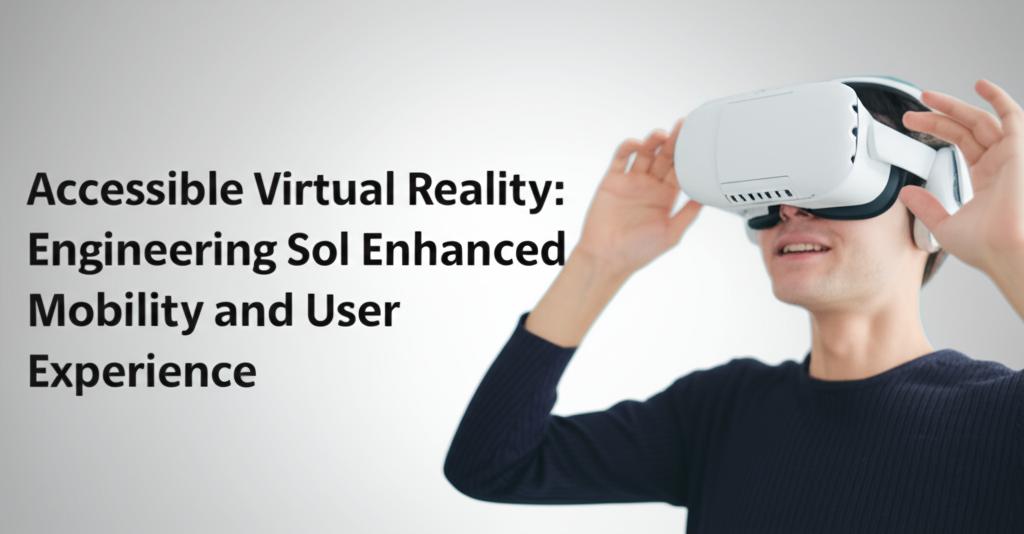Virtual reality (VR) is transforming how users interact with digital content and experience the world. However, ensuring these immersive experiences are accessible to everyone, especially individuals with mobility impairments, is crucial. Recent advancements in VR accessibility focus on innovative engineering solutions to enhance both mobility within virtual environments and the overall user experience.
Customizable Controls and Adaptive InterfacesA significant area of development involves customizable and adaptable control schemes. Recognizing that traditional VR interactions, often requiring broad physical movements, can be challenging or impossible for users with limited mobility, new tools are emerging. One such innovation is "MotionBlocks," a toolset developed by researchers at the University of Waterloo. This system allows users to customize game controls based on their specific physical capabilities. It enables users to define smaller, manageable movements—like a circular motion on a desk surface—which are then algorithmically translated into the larger gestures required by VR applications. This approach not only makes VR more inclusive but also reduces potential fatigue by aligning controls with the user's natural motion patterns.
Other advancements in this area include:
- Controller Customization: VR systems increasingly offer options to tailor controller configurations, including adapting them for one-handed use.
- Adaptive Interfaces: These interfaces offer customizable layouts and controls that adjust to individual user preferences and needs, accommodating varying levels of technical proficiency.
- Single-Button Navigation: This feature allows users to trigger world rotation or free movement with a single button press, reducing reliance on extensive physical motion.
For users with significant mobility impairments, hands-free interaction methods are paramount. Key developments include:
- Eye-Tracking Technology: This allows users to navigate VR environments and interact with elements using only their gaze, providing a vital hands-free option.
- Voice Commands: Sophisticated voice recognition technology enables users to navigate menus, interact with objects, and control their virtual surroundings using natural language. This is particularly beneficial for those who cannot easily use hand-held controllers.
- Gesture Recognition: This technology facilitates intuitive interactions for users who may have limited dexterity but can still perform certain hand or body gestures.
Enhancing sensory feedback beyond visual cues is another critical aspect of accessible VR:
- Haptic Feedback: Haptic devices, ranging from controllers to gloves or even full suits, provide tactile sensations like vibrations, textures, and resistance. This technology can convey spatial information through touch, improving immersion and awareness, especially for users who may also have visual impairments. Haptic feedback can simulate the feel of objects, confirm actions, or guide users within the virtual space.
- Audio Cues: Detailed and distinct audio cues can serve as a powerful navigation tool, helping users locate objects, understand spatial relationships, and receive confirmation of their interactions. Customizable audio settings allow users to adjust soundscapes based on their hearing abilities and ambient noise.
Artificial intelligence (AI) is playing an increasingly important role in tailoring VR experiences:
- AI-Driven Personalization: Machine learning algorithms can analyze user behavior and preferences to automatically adapt the VR environment, controls, and feedback to individual needs.
- AI-Powered Assistants: Future developments may include AI-driven personal assistants within AR/VR environments that can analyze surroundings, provide real-time guidance, and describe elements for users with various disabilities.
The development of accessible VR relies heavily on a user-centered design approach. This involves:
- Collaboration: Close collaboration between developers, accessibility experts, and end-users with disabilities is essential to identify barriers and co-design effective solutions.
- User Testing and Feedback: Actively engaging individuals with disabilities in testing and providing feedback throughout the development process ensures that accessibility is an integral part of the design, not an afterthought. This iterative process helps refine features and address real-world challenges.
Accessible VR has wide-ranging applications beyond gaming and entertainment. It is increasingly used in:
- Rehabilitation: VR environments provide safe and controlled spaces for physical therapy, helping individuals regain movement and coordination.
- Education and Training: Immersive simulations allow individuals, including those with mobility impairments, to practice job tasks and develop skills without physical limitations.
- Social Inclusion: Accessible VR platforms can provide important social spaces, enabling individuals with disabilities to connect with others and participate in shared experiences.
The ongoing commitment to accessibility in VR is not only a moral imperative but also a catalyst for innovation. By focusing on inclusive design, developers can create richer, more engaging, and ultimately more human-centered virtual experiences for everyone. The future points towards VR systems that are even more lightweight, ergonomic, and seamlessly adaptable to the diverse needs of all users, ensuring that the transformative power of virtual reality is truly within reach for all.

